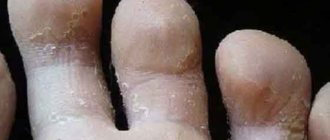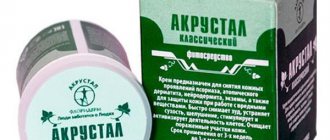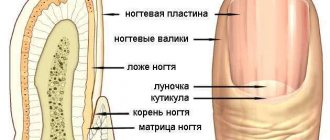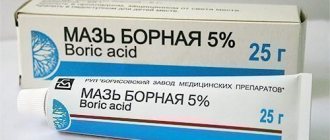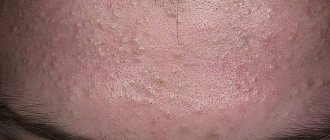Hands are a real indicator of the health of the human body. Skin color, dryness, excessive sweating, itching, etc. may indicate certain problems.
The most unpleasant manifestation on our hands can be called nail fungus (onychomycosis). Absolutely everyone is at risk, from children to old people, but people over 50 years of age, in particular women, are most often susceptible to the disease.
Early diagnosis without the help of a specialist is almost impossible; active, advanced forms of infection are usually treated. That is why we will tell you how and by what signs you can identify onychomycosis, what methods of control and prevention to use to protect yourself and your loved ones from infection.
What is nail fungus
Nail fungus is an infectious, dermatological disease caused by pathogenic fungi - parasites (in 90% of cases the causative agent is Trichophyton red), affecting the nail plate, the area under and around it. There are more than 50 varieties of fungi that can cause infection.
Symptoms:
Changed nail color . A pale white, yellowish tint appears, as a rule, at the initial stage; in subsequent stages, the color becomes greenish, purple, brownish or even black. But it is important not to confuse a banal nail injury with a fungus, since with a bruise, temporary stripes and dots on the plate may appear, as well as hemorrhage of the nail bed, which can provoke a black and blue color.
Compacted and keratinized nail plate . The nail appears inflamed, convex, unnaturally shaped, and hard to the touch.
Peeling of the nail . The shine is lost, the plate becomes soft, and peels off in different directions; this usually happens simultaneously on two or three fingers of each hand. The nail becomes terribly brittle and sensitive.
Stages of fungal development
Early - there are practically no symptoms, slightly noticeable stripes and spots may appear on the nails, the sensitivity of the fingertips becomes sensitive and painful, and sweating of the palms and fingers may also increase, causing a pungent odor.
The second is characterized by deformation of the circumference of the nail, darkening of color, dullness, and increased pain threshold.
Neglected - most often accompanied by loss of the nail, it becomes loose, the plate thickens and the peeling process occurs, as a result the nail lags behind the bed and breaks. At this stage, signs of burning and itching are also characteristic.
Lemon
If nail fungus appears, it is important to start treatment with lemon as early as possible. The following recipes will help with this.
- Turmeric (30 g) is diluted with lemon juice to form a mushy mixture. The composition is applied to the nail plate and left for 60 minutes.
- It is very easy to make compresses from citrus slices. To do this, cut a lemon, apply it to the affected areas, wrap it with a bandage and leave it for at least two hours.
- Crushed lemon (30 g) is combined with olive oil (10 ml), mixed thoroughly and applied in a thin layer to the nail plate. Each finger is wrapped in a bandage and removed after two hours.
- Not only pure juice is beneficial, but also lemon essential oil. In the evenings, apply a thin layer of oil for two weeks; it is important to wait until it dries completely.
There are no contraindications for lemon treatment. The only thing you should pay attention to is an allergy to citrus fruits.
Causes of fungus on fingernails
Genetics
People whose blood relatives had this disease are at greater risk of infection. Can be transmitted from an infected mother to her infant through breastfeeding.
Decreased immunity
It can be triggered by a common lack of vitamins or a recent cold, as well as long courses of antibiotic therapy.
Shared life
Infection from sick to healthy, through a damp towel or bed linen. Public places: handshaking, handrails in transport, money, as well as rooms with a high humidity environment - bathhouse, swimming pool, sauna, gym...
Visit to a manicurist
Unfortunately, one of the most common reasons is when a master, without treating and sterilizing instruments, transfers all the bacteria from one person to another.
Lifestyle
Nicotine, alcohol, and drugs disrupt all metabolic processes in the body, including the blood supply to the upper extremities, resulting in the process of the nail dying from the bed and fungus developing.
Skin infections
Eczema, dermatitis, allergic reactions, violate the integrity of the skin, the bacterium spreads throughout the skin of the hands and nails, including.
Diabetes
Due to elevated blood sugar levels, diabetics are very susceptible to any group of fungal diseases, both external and internal.
Insufficient hygiene
Failure to comply with general rules of personal hygiene also leads to onychomycosis; wash your hands as often as possible after contact with carriers and pathogens of bacteria (door handles, supermarket carts, transport, elevators, etc.)
Animals
They are often carriers of infection, especially if a pet walks outside, it can bring infection not just into your home, but also into your bed, dishes, which will lead to a lot of other serious diseases. Therefore, they need to wash their paws with laundry soap and treat them with antibacterial sprays after each visit to the street.
Types of fungal infection
There are several types of disease:
- Candidiasis, its appearance is influenced by fungi of the genus Candida.
- Trichophytosis - covers the nail plates, skin and mucous tissues of the body.
- Cryptococcosis is a fungus that attacks human internal organs.
- Aspergillosis, due to a weak immune system, the fungus affects the nails.
The fungus can be superficial or systemic.
When it is superficial, the skin and mucous membrane are affected, and when it is systemic, it affects the internal organs. Children are diagnosed with a fungal disease on the skin.
How to treat fingernail fungus, medications
Treatment in 80% of cases is protracted and difficult; it can last from two months to a year.
This process is always carried out by taking medications internally and using them externally. There is no miracle ointment that you apply once and everything will go away in nature, so treatment must be taken with particular seriousness, following the full course in accordance with the recommendations of the attending physician.
The doctor must determine the treatment tactics specifically for your case, taking into account the degree of damage, duration of the disease, and pathological changes that exist today.
A competent approach is the key to a quick and high-quality recovery!
Pills
They eliminate the cause of the disease from the inside, killing the pathogen itself, which lives and develops in the body. A course of antifungal drugs is prescribed, starting with a loading dose, gradually lowering it and reducing it to a minimum.
Important! Do not skip doses of medications and take them at the same time, no earlier than 12 hours after the last dose.
Medicines based on substances: terbinafine, flucanozole, clotrimazole...
Ointments
They act locally and effectively, it is recommended to apply not only to the nail, but also to the skin around it, as well as between the fingers, so that the fungus cannot spread to other areas of the hand. One ointment can be used for no more than two months, as resistance (addiction) to the active substance may develop, and it will simply stop working.
Medicines: canespor, miconazole, lamisil uno, exoderil, nystatin...
Drops
The principle of treatment is the same as that of ointment due to local action, but drops are considered more effective, they penetrate much deeper into the affected parts of the nail itself and the skin under it, which cannot be achieved with ointment, and the treatment process itself is faster.
Medicines: exoderil, clotrimazole, terbinafine, flucanozole...
Lucky
They are used exclusively in the early stages of diagnosing the problem, when the shape and density of the nail is not yet deformed; it can also be used for preventive purposes if someone in the family suffers from this disease.
Medicines: Demicten, Batrafen, Nylner...
Bacterial complications
Paronychia is the medical name for bacterial complications. They manifest themselves through inflammatory processes. When bacteria penetrate the affected area, obvious symptoms occur:
- Pain syndrome;
- Edema;
- Redness;
- Temperature increase;
- Discharge of pus.
Bacterial complications can be prevented by using antifungal varnish. It creates a dense film on the surface through which pathogenic microorganisms do not penetrate.
How to properly prepare a nail for treatment
- Steam your hands in a solution - 1 liter of water, 20 grams of laundry soap, 1 tablespoon of soda, 10 drops of iodine.
- Before going to bed, at night, lubricate your nails with salicylic ointment in a loose, thin layer.
- In the morning, use a rough nail file or sharp object to remove the affected layer, but do not overdo it.
- Apply the external agent to the treated surface; it will be able to penetrate deep into the pores and tissues and create a protective, healing film for approximately 48 - 72 hours.
Apple vinegar
Let's look at how to properly use apple cider vinegar for fingernail fungus.
- To prepare the simplest compress, you need to mix vinegar and warm water in a ratio of 1 to 8. Soak a bandage in the liquid and wrap each finger, leave for 15 minutes.
- For a more effective option, you need to mix vodka (30 ml), glycerin (15 ml) and vinegar (30 ml). The bandage is generously moistened and wrapped around the fingers and left for 15 minutes.
- To prepare the ointment, combine vinegar (5 ml), crushed kolanchoe (50 g), bee nectar (5 ml) and eucalyptus tree oil (15 ml). All components are thoroughly mixed, poured into a clean glass container, sealed hermetically and set aside in a dark place for four days. The ointment is applied to the affected areas twice a day.
Vinegar formulations should not be used if the patient:
- there are fresh wounds or scratches on the skin;
- hypersensitive epidermis.
How to cure fingernail fungus with folk remedies
Traditional methods have always enjoyed increased popularity; they are simple, accessible and effective, passed down from generation to generation and are often the only salvation for many ailments.
The most effective folk methods:
Tar soap
At night, you need to soap the affected nails with tar and wet soap, then sprinkle them with salt and bandage them, do this for a week.
Celandine
Prepare a paste from the dry powder of the plant, apply it to the affected areas twice a day and keep for 15-30 minutes, duration 5-7 days. The nails should come off and peel off, this process will not cause pain, but the aesthetic appearance will not be initially attractive, but strong, new, healthy nails will grow.
Treatment with smoke
Wrap a cotton piece of fabric in a tube, set it on fire at one end and wait until it flares up, put out the fire and fumigate your nails with smoke from the fabric. The smoke penetrates deeply, gets into every pathogenic particle and provokes exfoliation of keratinized tissue.
Tea mushroom
The skin around the nails should be treated with a softening, nourishing cream or salicylic ointment. Place a piece of kombucha (preferably peroxided) on your nails, wrap it in plastic wrap or cellophane and wrap it tightly with a bandage, sleep with this design all night. After the first application, the nail will become soft and the entire affected surface can be easily removed, after which preventive measures can be used until a healthy nail grows.
Poplar bud tincture
Half a glass of kidneys, pour half a liter of vodka or 70% alcohol, leave for 10 days. Apply a compress at night, usually once is enough to soften and remove the entire diseased part of the nail, but if necessary, the procedure can be repeated two to three times.
Propolis
It’s good to steam your fingers in a cool solution of manganese, mix grated propolis with alcohol in a 1:1 ratio, apply the paste to your nails and wrap it with a bandage, repeat the whole process every other day until complete recovery.
Glycerin and vinegar
Sweep glycerin with a 70 percent solution of acetic acid in equal quantities, apply the liquid daily, 2-4 times to the nails, shake the container well before each use. The course is at least three weeks.
Tea tree oil
It itself has the strongest antifungal properties, for any surface of the skin, and is recommended for use on dermatological problems on the face. Before applying to nails, they need to be steamed in a 1:1 solution of vinegar and manganese, then thoroughly rub in the oil with light massage movements, distributing evenly.
Iodine
The cheapest method! Apply one drop to the affected nail to prevent the infection from spreading; it is recommended to treat healthy areas as well. Treatment can be considered successful when sensitivity returns to the nails and you feel a burning sensation around and under the nails.
Garlic
Apply a compress of garlic pulp externally every day, for a quick effect, drink garlic tincture with vodka or eat it in its pure form. The course is from six days to two weeks.
Attention! The method cannot be used by people with hypertension, as garlic can increase blood pressure and increase heart rate.
Apple vinegar
Make baths by mixing it with water in equal proportions and immerse your hands in them for half an hour before going to bed, or make lotions at night from vinegar and vegetable oil.
Onion juice
Grate the onion or pass through a meat grinder, squeeze out the juice from the pulp and treat the fungal area with it up to five times a day. Course 10-14 days.
Rowan
Pass the rowan leaves through a meat grinder or crush in a mortar, apply the resulting mixture to the nails, wrap with film and a bandage for 30 minutes - 1 hour, repeating the procedure every other day until complete recovery.
Strong tea decoction
Used in the form of lotions, use several times a day for no more than one week. It serves rather as an adjunct to drug treatment.
Novocaine
Used in fungal stages when decay occurs with pain. We treat the cotton wool with a solution of novocaine (sold in a pharmacy) and put the lotion on the sore spot, hold it until the pain subsides.
Strong coffee
Dip your hands in a solution of strong coffee before going to bed for about 10 minutes, usually 2-4 sessions are enough for treatment, it all depends on the degree of damage.
DIY ointment
Mix 100 milliliters of vinegar 70% with 200 grams of melted butter and put 1 chicken egg in the shell into the mixture and leave it in the refrigerator for a week, the shell will dissolve during this time and the ointment can be considered ready. Use once a day for at least one week. Store the finished product in the refrigerator for no more than a month.
DIY solution
Mix 100 grams of the Kalanchoe plant with 1 tablespoon of liquid honey, one spoon of apple cider vinegar and 30 milliliters of eucalyptus oil, keep the solution in a dark, cool place for three days. Wipe your nails once a day, the course is individual.
Tar soap
This tool can be used in several ways; let’s look at the most popular ones.
1st method. Classical
The main component is ground on a grater. A liter of hot water is mixed with 30 grams of soap and stirred until completely dissolved. Cool to 45°C and put your hands down for 15 minutes. The procedure is carried out three times a week.
2nd method. Salt and tar soap for nail fungus
10 g of sea salt and 30 g of grated soap are diluted in a small amount of water. The procedure is carried out daily for 15 minutes.
3rd method. Gauze compresses
Similarly to the first method, dilute soap with water. The resulting mixture is used to treat the affected areas, each finger is wrapped in gauze soaked in soapy water and covered with cling film. The compress is left for at least three hours, the procedure is carried out daily.
However, it is worth considering that it is not recommended to use products based on tar soap against nail fungus under certain circumstances, for example, such as:
- personal intolerance;
- skin hypersensitivity;
- dermatitis.
There are several other ways to treat nail fungus
Surgical method
A painful, lengthy process is carried out by completely removing the nail plate, after which you need to apply healing ointments and go without a nail for some time until a new one grows. But you need to be prepared for the fact that a deformed nail will grow, thicker than the rest, this happens in most cases.
The affected part is cleaned, preserving the healthy area of the nail as much as possible, then it is covered with a special pigment varnish, which highlights the diseased cells with a dark flower, the colored areas are removed using a laser beam, the degree of exposure to ultraviolet radiation can be controlled by the color of the nails until the color becomes uniform along the entire perimeter, and all age spots will not disappear.
The method is not cheap, but very effective, since the laser penetrates completely to the full depth of the nail plate. The course is usually 10 – 12 procedures. This can be done in private clinics or specialized beauty salons.
Contraindications for laser therapy:
- any history of tumors;
- immunodeficiency;
- diseases of the endocrine system;
- allergic skin diseases;
- epilepsy;
- pregnancy, lactation;
- tan less than two weeks old;
- excessive dryness of the area requiring treatment;
- coagulopathy.
Diagnostics
Changes in the shape, structure, and color of the nail are not always caused by a fungal infection. Onychomycosis on the hands accounts for only 30-40% of all nail diseases, and they begin to treat the fungus only after all diagnostic measures have been carried out.
The goal of diagnosis is to confirm fungal infection using microscopic examination and determine the type of fungus to select a treatment regimen.
A picture similar to a fungal infection is caused by psoriasis, eczema, and various injuries to the nail plate. These diseases are also accompanied by delamination, deformation of the nail plate, the appearance of grooves, spots, and discoloration.
Prevention of fingernail fungus
A person who has at least once encountered the problem of nail fungus must adhere to preventive measures, since this unpleasant process tends to return, affecting an increasing amount of space each time.
Prevention:
- Observe the rules of personal hygiene, fungus infests in any damp environment, laundry soap and hand sprays containing alcohol will help protect yourself from the disease.
- Every three months, drink a vitamin complex containing vitamins A, B, E and zinc.
- Nutrition should be structured in such a way that there is no deficiency of macro and micro elements necessary for life. The weekly diet should include meat, fish, legumes, eggs, cottage cheese, milk, nuts, cheese, liver, vegetables, fruits.
- Perform manicures at home with your own personal tools, or supervise the processes of sterilization of instruments, files and brushes by a specialist in the salon, since in this way you can get not only fungal infection, but also HIV, hepatitis, etc.
Remember! Whatever type of fungus you become infected with, the main task remains to detect it in time and begin the treatment process immediately. The development of any misfortune can be prevented if you pay due attention to your health and learn to listen to your body.

